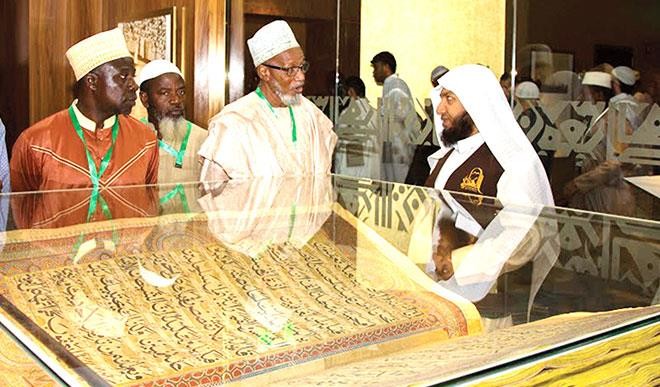
The city of Medina, Saudi Arabia holds a lot of religious significance to the entire Muslim world. It is the city that hosted and supported Prophet Mohammed (Peace be upon him) when he was rejected by his people in Mecca.
In 622C.E. the prophet left Mecca to Yathrib later renamed Madina with his followers and companions. For 10 years, he found a home in Medina and fended off invading enemies and established a state where Islam flourished and was passed to today’s generation.
Over the last 1400 years, the political capital of the Muslim world had moved to other parts of the world, including Syria, Iraq and Constantinople in modern day Turkey. Ultimately, it returned to Saudi Arabia, where the two holy mosques – the Ka’aba in Mecca and the prophet’s mosque in Medina – are situated.

I was part of a 250-member delegation from 10 African countries, including Nigeria on umrah and visited under the auspices of the Saudi Arabia government in March 2016. It was a 10-day programme involving visits to tourist sites and iconic institutions in the kingdom.
One of the places we visited was the Holy Quran Exhibition Centre besides the prophet’s mosque in Medina.
In this centre is the largest handwritten copy of the Glorious Qur’an. Due to the age of the papers and copies, in taking photograph, use of flash is disallowed as it damages the already fragile papers in the long term.
Our guide was Ibrahim, an American and a student at the University of Medina. At the centre is a copy of the last juz Amma (1/30) of the Quran, hand written.
Each line in the copy starts with the letter alif (I) with flawless legibility. It’s written by hand in 60 pages. It is more than 150 years old. “Nobody knows when it was written but they know when it was given,” said Ibrahim, who spoke impeccable English.

Then came the large copy of the Qur’an; the largest hand written copy of the holy book, weighing 154 kilogrammes. It was written by a man by the name Ghulam Muhyideen from the Afghanistan/Pakistan region with marginal annotations. It has translation as footnotes on each page in red colour. It was written 197 years ago.
There are dozens other copies of the Qur’an of different sizes most of them hand written, delicately preserved in closed glass casings. There is a particular copy which was written in Andalus, modern day Spain. The calligraphy is unique and scarce. Ibrahim said it was only in Nigeria that such calligraphy was still in use in the writing of the Qur’an.
Then, there are the six beautiful cabinets bearing copies of the Qur’an. They were donated to the prophet’s mosque by a princess from Egypt more than 100 years ago. They are made of silver and ivory.
Also at the centre, is a copy of the Qur’an that was written more than 950 years ago in the Maghreb (present day North Africa). Other than that, it was written in the Persian scripts. “That means you don’t have to be an Arab only to work for the deen (Islam as a religion),” the eloquent Ibrahim explained.
Another unique feature of this copy is that everywhere the name of Allah is found, it is written in pure gold ink. Yet another copy of the Qur’an preserved at the exhibition centre has the three different styles of recitation of the Qur’an explained in footnotes, tafsir (commentary of the Qur’an) by Jalalain as well as translation of the Qur’an.

Then there is the screen shot of pages from the original copy of the Qur’an written in the time of Caliph Uthman bn Affan, about a decade after the prophet’s death.
The Qur’an was not compiled in a book form during the life time of the prophet. It was written in patches, animal skins, tablets and many of his companions had the entire Qur’an in memory.
After the death of the prophet in 632C.E. Caliph Abubakar became the commander-in chief of the growing Muslim empire. The Qur’an was then encoded into a book form, written in different styles. That copy can no longer be found any were. During the reign of Uthman, the copy was standardised. That copy can still be found in a museum in Turkey.

A section of the exhibition centre is dedicated to pictorial exaltations, promoting the significance of reciting the Qur’an. At the middle of one of the halls is a big projector, showing a short movie depicting the pre-Islamic Arabia where idolatry was the order of the day. The period is generally regarded as the jahiliyah era (period of ignorance) where life was akin to survival of the fittest.
Then came Prophet Mohammed (Peace of Be upon Him) with the divine message of the Qur’an, moving mankind from the shackles of darkness to light. “With the Qur’an, the edifice of civilization was born,” a voice over in the movie said.
The short movie closes with modern day Medina with the prophet’s mosque and Ka’aba in Mecca adorned with beautiful designs and having millions of worshippers.
Inside King Fahd’s Complex
In the heart of Medina is a printing press, dedicated to the printing of copies of the glorious Qur’an. The delegation visited the sprawling and beautiful building housing the press. As you come into the office, you are welcome by a huge sculpture of a copy of the Qur’an at the centre of the expansive compound.

The next minute, we were ushered into an equally huge reception with giant screen projection, displaying the uniqueness of the Qur’an.
Minutes later, we were led through a narrow alley to an upper floor overlooking the printing press. Here, men of different nationalities are seen, each manning a section of the press, pushing a button or placing the papers appropriately in the machine. At one end of the halls, the finished copies roll out in their numbers as the machines hum in a rhythmic cadence.
After few minutes of photo shoot by the delegation, we were on our way back to the waiting buses. As we stepped out, at one of the doors, some staff handed over two copies of the Qur’an to each guest; one in Arabic and another in the language of your choice from Hausa, Yoruba to English.
Every year, 10 million copies of the Qur’an are printed here in different languages and distributed for free all over the world. The government of Saudi Arabia is looking to increase the print run to 12 million annually from 2016.
I learnt it was a rare privilege for us to have been allowed to go into the press. Guests are often restricted to the other parts of the press.
Reasons Saudis love white robes and cars
Most men you see in Mecca and Medina are often in white robes. The Uba mosque, one of the places we visited in Medina, is painted white. Inside the mosque, most of the worshippers were in white robes and you have a colourful kaleidoscope of white.

I inquired from one of our guides, Abdulkareem Ibrahim why they were so glued to white garments, even white cars. Most of the cars on the roads are white and posh. “The white garment is a national dress every Arab wishes to wear,” he told me. To match is the red salve held on the head with a black ring.
Walid Qoura, the media team leader also said because the prophet said the best colour was white; they are therefore more attracted to wear white cloaks.
On the preference for white cars, Ali Tamimi, a movie director, who returned from America last year after a master’s degree, explained further: “White and black cars command higher value and price here in Saudi Arabia when you have to resell,” he said. “In the summer, we prefer the white garment because it’s light.”
That pushed me to ask why the Saudis are eternally stuck with the use of sandals and flat shoes even when they have some expensive clothes on. “It is because of the (desert) terrain. It is hot here. There are sandals in Saudi that cost $400 (N80, 000). They are not just sandals but quality ones. You can go visit the king in sandals but not just any sandals,” Ibrahim volunteered. “It is an informal wear and in formal setting, the individual would definitely be better dressed,” he added in fluent English.
%20chat%20after%20receiving%20copies%20of%20the%20Glorious%20Quran%20from%20the%20printing%20press.jpg)
Not done, I asked if it was true that some super rich people in the kingdom drive in gold-plated cars. “No one rides in gold-plated cars. I have never seen one in my life,” Ibrahim said in defence.
Somehow, it appeared he didn’t quite get the joke. While we we were chatting, the Internet was abuzz with reports of a young man in his twenties believed to be from Saudi Arabia who flew into the city of London some gold-plated cars worth £1 million (N280 million).

 Join Daily Trust WhatsApp Community For Quick Access To News and Happenings Around You.
Join Daily Trust WhatsApp Community For Quick Access To News and Happenings Around You.


